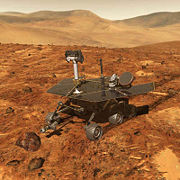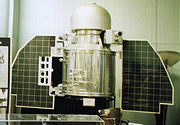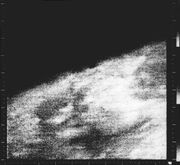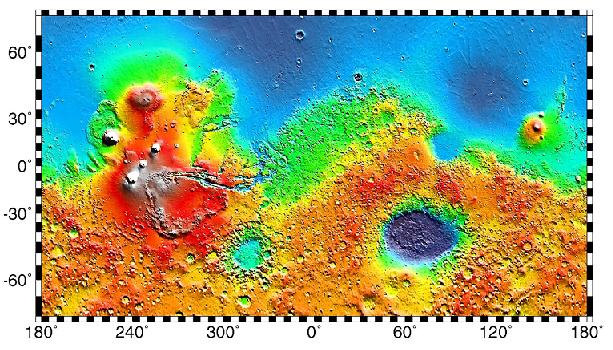Exploration of Mars
2008/9 Schools Wikipedia Selection. Related subjects: Space transport

The exploration of Mars has been an important part of the space exploration programs of the Soviet Union (later Russia), the United States, Europe, and Japan. Dozens of robotic spacecraft, including orbiters, landers, and rovers, have been launched toward Mars since the 1960s. These missions were aimed at gathering data about current conditions and answering questions about the history of Mars. The questions raised by the scientific community are expected to not only give a better appreciation of the red planet but also yield further insight into the past, and possible future of Earth.
The exploration of Mars has come at a considerable financial cost with roughly two-thirds of all spacecraft destined for Mars failing before completing their missions, with some failing before they even begin. Such a high failure rate can be attributed to the complexity and large number of variables involved in an interplanetary journey, and has led researchers to jokingly speak of The Great Galactic Ghoul which subsists on a diet of Mars probes. This phenomenon is also informally known as the Mars Curse. As of 2008, there are three functioning pieces of equipment on the surface of Mars beaming signals back to Earth: the Spirit rover, the Opportunity rover, and the Phoenix lander.
The planet Mars
Mars has long been the subject of human fascination. Early telescopic observations revealed colour changes on the surface which were originally attributed to seasonal vegetation as well as linear features which were ascribed to intelligent design. These early and erroneous interpretations led to widespread public interest in Mars. Further telescopic observations found Mars' two moons - Phobos and Deimos, dry channels and depressions, polar ice caps, Olympus Mons, the solar system's tallest mountain, and Valles Marineris, the solar system's largest canyon system. These discoveries have only piqued further interest in the study and exploration of the red planet. Mars is a rocky planet, like Earth, that formed around the same time, yet with only half the diameter of Earth, and a far thinner atmosphere, it has a cold and desert-like surface. (It is notable, however, that although the planet has only one quarter of the surface area of the Earth, it has about the same land area, since only one quarter of the surface area of the Earth is land).
Launch windows
In order to understand the history of the robotic exploration of Mars it is important to note that minimum-energy launch windows occur at intervals of 2.135 years, i.e. 780 days (the planet's synodic period) with respect to Earth. This is a consequence of the Hohmann transfer orbit for minimum-energy interplanetary transfer. Launch windows were / will be in:
- November to December 1996
- December 1998 to January 1999
- April 2001
- June to July 2003
- August 2005
- October 2007
- December 2009
- February 2012
Like the outbound launch windows, minimum energy inbound (Mars to Earth) launch windows also occur at intervals of 780 (Earth) days.
In addition to these minimum-energy trajectories, which occur when the planets are aligned so that the Earth to Mars transfer trajectory goes halfway around the sun, an alternate trajectory which has been proposed goes first inward toward Venus orbit, and then outward, resulting in a longer trajectory which goes about 360 degrees around the sun (" opposition-class trajectory"). Although this transfer orbit takes longer, and also requires more energy, it is sometimes proposed as a mission trajectory for human missions.
Early flyby probes and orbiters
Early Soviet missions
The Marsnik program, was the first Soviet unmanned spacecraft interplanetary exploration program, which consisted of two flyby probes launched towards Mars in October 1960, Marsnik 1 and 2 dubbed Mars 1960A and Mars 1960B (also known as Korabl 4 and Korabl 5 respectively). After launch, the third stage pumps on both Marsnik launchers were unable to develop enough thrust to commence ignition, so Earth parking orbit was not achieved. The spacecraft reached an altitude of 120 km before reentry.
Mars 1962A a Mars fly-by mission, launched on October 24, 1962 and Mars 1962B a lander mission, launched in late December of the same year both failed from either breaking up as they were going into Earth orbit or having the upper stage explode in orbit during the burn to put the spacecraft into the Mars trajectory.
Mars 1 (1962 Beta Nu 1) an automatic interplanetary station launched to Mars on November 1, 1962 was the first probe of the Soviet Mars probe program. Mars 1 was intended to fly by the planet at a distance of about 11,000 km and take images of the surface as well as send back data on cosmic radiation, micrometeoroid impacts and Mars' magnetic field, radiation environment, atmospheric structure, and possible organic compounds. Sixty-one radio transmissions were held, initially at two day intervals and later at 5 days in which a large amount of interplanetary data was collected. On 21 March 1963, when the spacecraft was at a distance of 106,760,000 km from Earth, on its way to Mars, communications ceased, due to failure of the spacecraft's antenna orientation system.
In 1964, both Soviet probe launches, of Zond 1964A on June 4, and Zond 2 on November 30, (part of the Zond program), resulted in failures. Zond 1964A had a failure at launch, while communication was lost with Zond 2 en route to Mars after a mid-course maneuver, in early May 1965.
Mariner program
In 1964, NASA's Jet Propulsion Laboratory made two attempts at reaching Mars. Mariner 3 and Mariner 4 were identical spacecraft designed to carry out the first flybys of Mars. Mariner 3 was launched on November 5, 1964, but the shroud encasing the spacecraft atop its rocket failed to open properly, and it failed to reach Mars. Three weeks later, on November 28, 1964, Mariner 4 was launched successfully on a 7½-month voyage to the red planet.
Mariner 4 flew past Mars on July 14, 1965, providing the first close-up photographs of another planet. The pictures, gradually played back to Earth from a small tape recorder on the probe, showed lunar-type impact craters.
NASA continued the Mariner program with another pair of Mars flyby probes, Mariner 6 and 7, at the next launch window. These probes reached the planet in 1969. During the following launch window the Mariner program again suffered the loss of one of a pair of probes. Mariner 9 successfully entered orbit about Mars, the first spacecraft ever to do so, after the launch time failure of its sister ship, Mariner 8. When Mariner 9 reached Mars, it and two Soviet orbiters ( Mars 2 and Mars 3, see Mars probe program below) found that a planet-wide dust storm was in progress. The mission controllers used the time spent waiting for the storm to clear to have the probe rendezvous with, and photograph, Phobos. When the storm cleared sufficiently for Mars' surface to be photographed by Mariner 9, the pictures returned represented a substantial advance over previous missions. These pictures were the first to offer evidence that liquid water might at one time have flowed on the planetary surface.
Surface missions
The following is a map of landings on Mars.
The first probes landed on Mars were by the Soviet Union's Mars 2 and Mars 3, as part of the Mars probe program. The Mars 2 and 3 probes each carried a lander, both of which failed upon landing. However, the Mars 3 lander was able to send the first image from the surface of Mars. These also contained the first Mars rovers, although both were broken on landing.
The first successful American landers were Viking 1 & 2
Mars Curse
The high failure rate of missions launched from Earth attempting to explore Mars has become informally known as the Mars Curse. Some suggest in jest, that there is some supernatural force trying to prevent or punish the exploration of Mars. The Galactic Ghoul is a fictional space monster that consumes Mars probes, a term coined in 1997 by Time Magazine journalist Donald Neff.
Of 38 launches from Earth in an attempt to reach the planet, only 19 succeeded, a success rate of 50%. Twelve of the missions included attempts to land on the surface, but only seven transmitted data after landing.
The U.S. NASA Mars exploration program has had a somewhat better record of success in Mars exploration, achieving success in 13 out of 18 missions launched (a 72% success rate), and succeeding in six out of seven (an 86% success rate) of the launches of Mars landers.
|
|||||||||||
Manned missions
Many people have long advocated a manned mission to Mars as the next logical step for a manned space program after lunar exploration. Aside from the prestige such a mission would bring, advocates argue that humans would easily be able to outperform robotic explorers, justifying the expenses. Critics contend, however, that robots can perform better than humans at a fraction of the expense.
Timeline of Mars exploration
| Mission (1960-1969) | Launch | Arrival at Mars | Termination | Objective | Result |
|---|---|---|---|---|---|
| 10 October 1960 | 10 October 1960 | Flyby | Launch failure | ||
| 14 October 1960 | 14 October 1960 | Flyby | Launch failure | ||
| 24 October 1962 | 24 October 1962 | Flyby | Broke up shortly after launch | ||
| 1 November 1962 | 21 March 1963 | Flyby | Some data collected, but lost contact before reaching Mars | ||
| 4 November 1962 | 19 January 1963 | Lander | Failed to leave Earth's orbit | ||
| 4 June 1964 | 4 June 1964 | Flyby | Launch Failure | ||
| 5 November 1964 | 5 November 1964 | Flyby | Failure during launch ruined trajectory. Currently in solar orbit. | ||
| 28 November 1964 | 14 July 1965 | 21 December 1967 | Flyby | Success (first successful flyby) | |
| 30 November 1964 | May 1965 | Flyby | Lost contact | ||
| 25 February 1969 | 31 July 1969 | August 1969 | Flyby | Success | |
| 27 March 1969 | 5 August 1969 | August 1969 | Flyby | Success | |
| 27 March 1969 | 27 March 1969 | Orbiter | Launch failure | ||
| 2 April 1969 | 2 April 1969 | Orbiter | Launch failure | ||
| Mission (1970-1989) | Launch | Arrival at Mars | Termination | Objective | Result |
| 8 May 1971 | 8 May 1971 | Orbiter | Launch failure | ||
| 10 May 1971 | 12 May 1971 | Orbiter | Launch failure | ||
| 30 May 1971 | 13 November 1971 | 27 October 1972 | Orbiter | Success (first successful orbit) | |
| 19 May 1971 | 27 November 1971 | 22 August 1972 | Orbiter | Success | |
| 27 November 1971 | Lander / rover | Crash landed on surface of Mars | |||
| 28 May 1971 | 2 December 1971 | 22 August 1972 | Orbiter | Success | |
| 2 December 1971 | Lander / rover | Success (first successful landing) Landed softly, but ceased transmission within seconds | |||
| 21 July 1973 | 10 February 1974 | 10 February 1974 | Orbiter | Did not enter orbit, but made a close flyby | |
| 25 July 1973 | 2 February 1974 | 21 February 1974 | Orbiter | Partial success. Entered orbit, and returned data, but failed within 9 days | |
| 5 August 1973 | 12 March 1974 | 12 March 1974 | Lander | Partial success. Data returned during descent, but not after landing on Mars | |
| 9 August 1973 | 9 March 1974 | 9 March 1974 | Lander | Landing probe separated prematurely; entered heliocentric orbit. | |
| 20 August 1975 | 20 July 1976 | 17 August 1980 | Orbiter | Success | |
| 13 November 1982 | Lander | Success | |||
| 9 September 1975 | 3 September 1976 | 25 July 1978 | Orbiter | Success | |
| 11 April 1980 | Lander | Success | |||
| 7 July 1988 | 2 September 1988 | Orbiter | Contact lost while on route to Mars | ||
| Phobos | lander | Not deployed | |||
| 12 July 1988 | 29 January 1989 | 27 March 1989 | Orbiter | Partial success: entered orbit and returned some data. Contact lost just before deployment of landers | |
| 2 Phobos | Landers | Not deployed | |||
| Mission (1990-1999) | Launch | Arrival at Mars | Termination | Objective | Result |
| 25 September 1992 | 24 August 1993 | 21 August 1993 | Orbiter | Lost contact just before arrival | |
| 7 November 1996 | 11 September 1997 | 5 November 2006 | Orbiter | Success | |
| 16 November 1996 | 17 November 1996 | Orbiter / landers | Launch failure | ||
| 4 December 1996 | 4 July 1997 | 27 September 1997 | Lander / rover | Success | |
| 3 July 1998 | 9 December 2003 | Orbiter | Complications while on route; Never entered orbit | ||
| 11 December 1998 | 23 September 1999 | 23 September 1999 | Orbiter | Crash landed on surface due to metric-imperial mix-up | |
| 3 January 1999 | 3 December 1999 | 3 December 1999 | Lander | Lost contact just before arrival | |
| Landers | |||||
| Mission (2000-) | Launch | Arrival at Mars | Termination | Objective | Result |
| 7 April 2001 | 24 October 2001 | Currently operational | Orbiter | Success | |
| 2 June 2003 | 25 December 2003 | Currently operational | Orbiter | Success | |
| 6 February 2004 | Lander | Lost contact while landing; Assumed to have crash landed | |||
| 10 June 2003 | 4 January 2004 | Currently operational | Rover | Success | |
| 7 July 2003 | 25 January 2004 | Currently operational | Rover | Success | |
| 2 March 2004 | February 25, 2007 | Currently operational | Flyby | Success | |
| 12 August 2005 | 10 March 2006 | Currently operational | Orbiter | Success | |
| 4 August 2007 | 25 May 2008 | Currently operational | Lander | Success (to date) | |
| 27 September 2007 | (June 2009) | Currently operational | Flyby on way to Vesta | (Successful launch; successful to date) | |
| Future missions | Launch schedule | Estimated arrival at Mars | Objective | Notes | |
| September 2009 | August 2010 | Lander | Powered by radioisotopes, it will perform chemical and physical analysis on martian soil and atmosphere. | ||
| October 2009 | September 2010 | Orbiter, lander, sample return | Will attempt to bring samples of Phobos’ soil back to Earth on 2012. | ||
| 2009 | Lander | ||||
| 2013 | Orbiter, lander, rover | ||||
| 2013 | Lander | Part of the Mars Scout Mission; the exact probe is yet to be selected. | |||
| 2018 | Orbiter, lander, rover, sample return | Not scheduled but being considered. |
Cancelled missions
- Voyager - 1970s - Two orbiters and two landers, launched by a single Saturn V rocket.
- Mars Aerostat - Russian/French balloon mission, originally planned for the 1992 launch window, postponed to 1994 and then to 1996 before being cancelled .
- Mars-98 - Russian mission including an orbiter, lander, and rover, planned for 1998 launch opportunity
- Mars Surveyor 2001 Lander - October 2001 - Mars lander
- NetLander - 2007 or 2009 - Mars netlanders
- Mars Telecommunications Orbiter - September 2009 - Mars orbiter for telecommunications
- Wright Flyer Mars airplane micromission, proposed for December 17, 2003, the centennial of the Wright brother's first flight.




